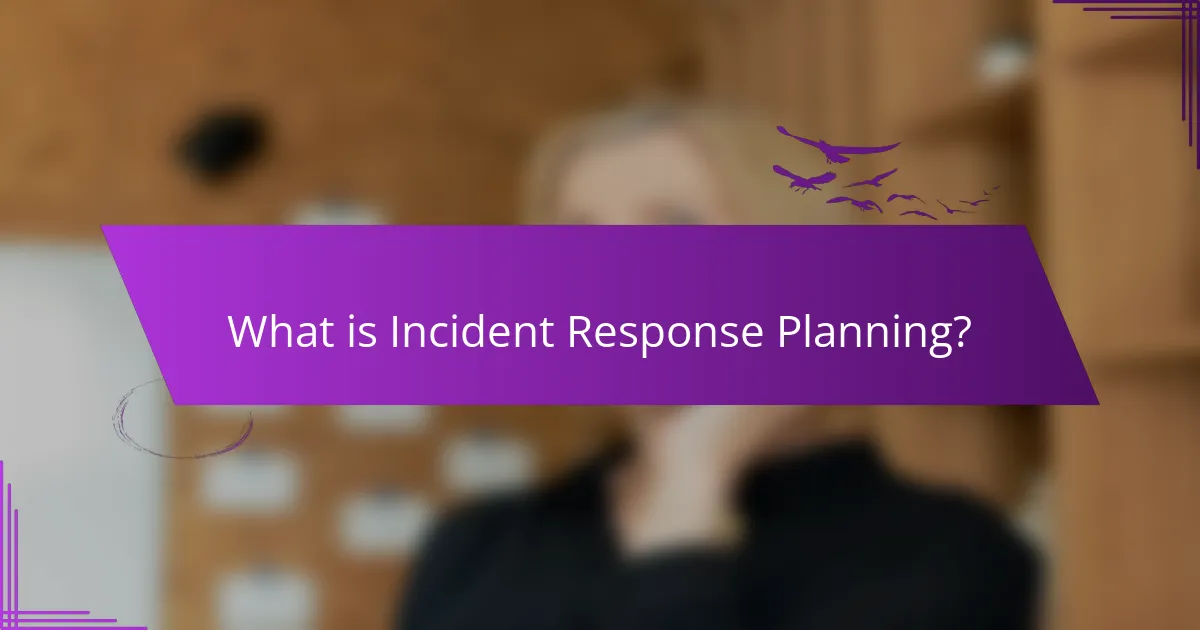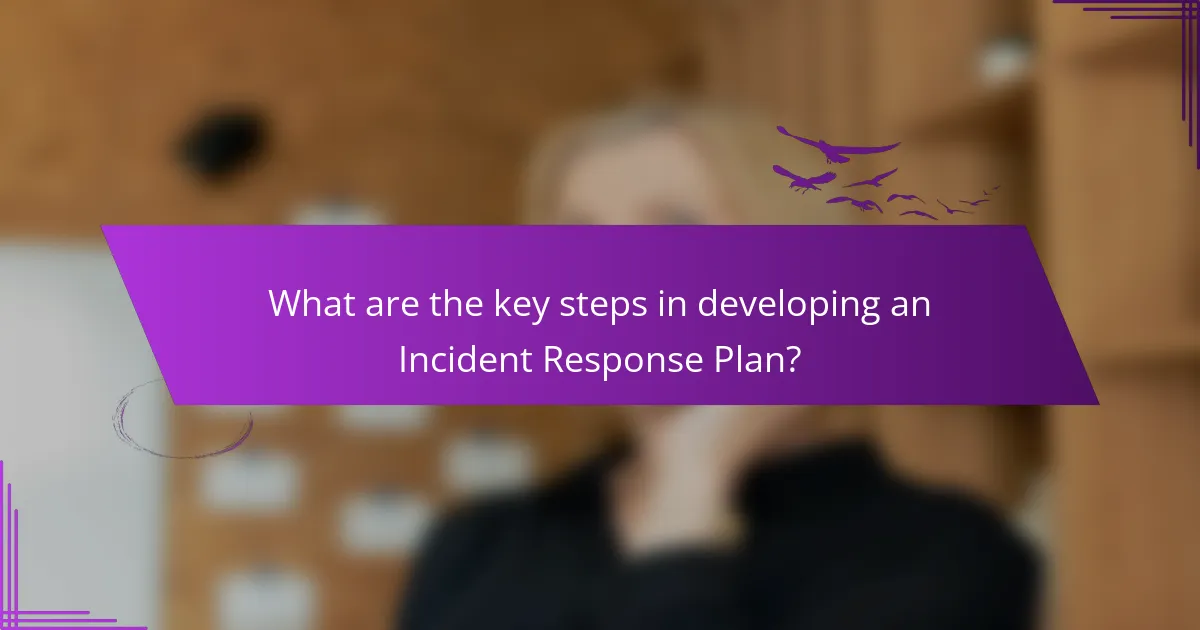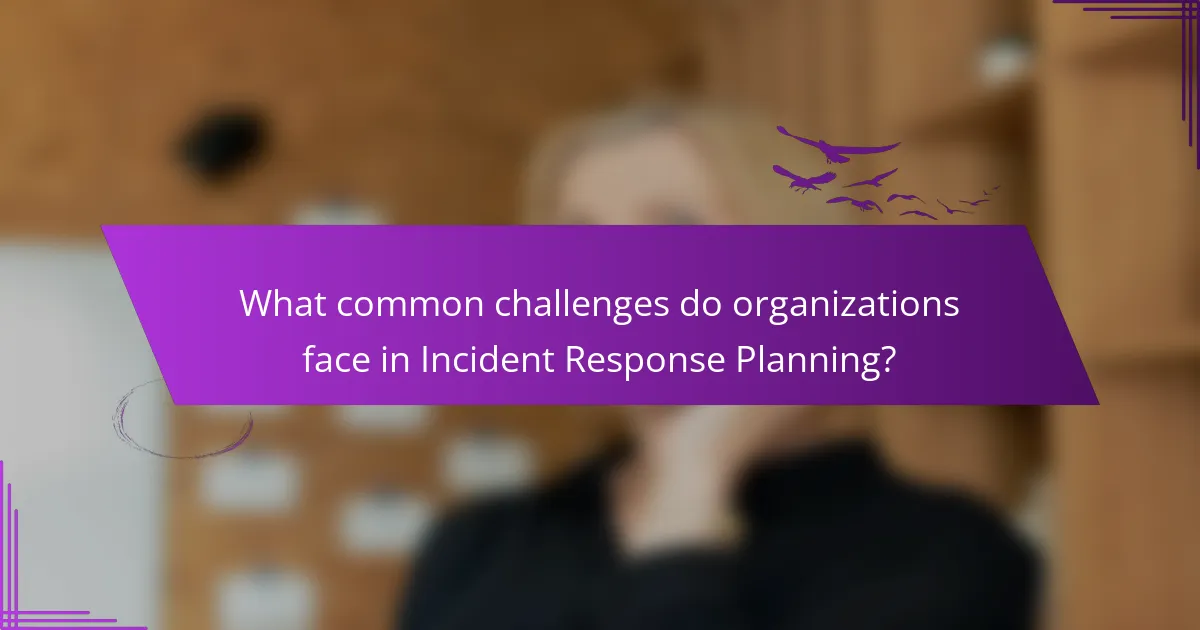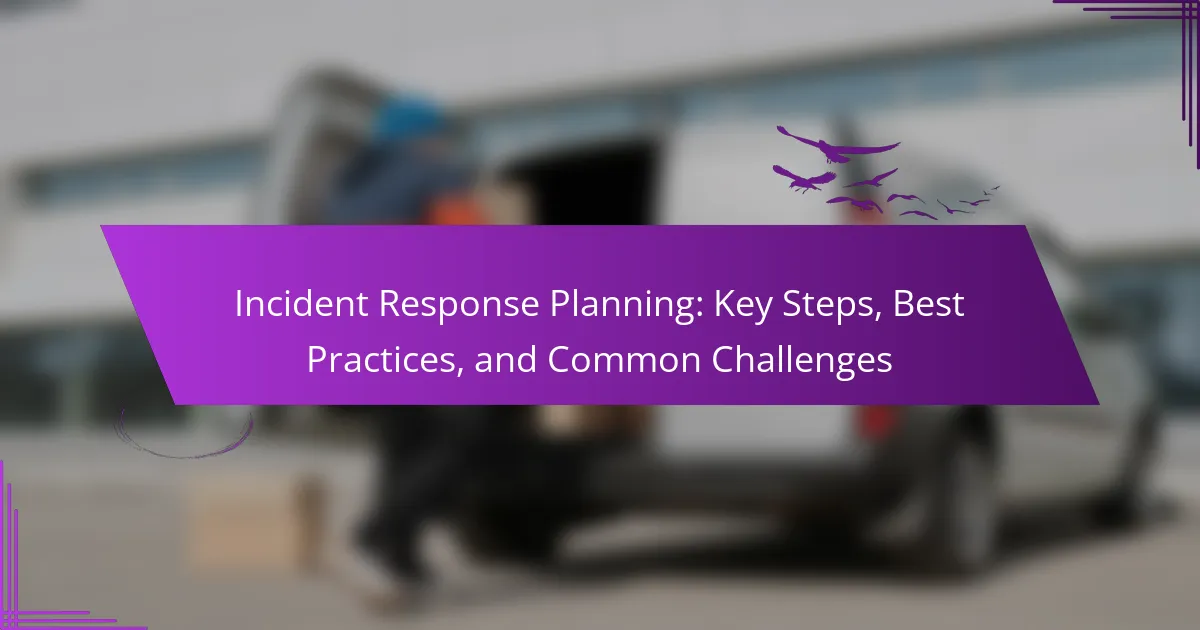
What is Incident Response Planning?
Incident response planning is the process of preparing for and managing cybersecurity incidents. It involves creating a structured approach to detect, respond to, and recover from security breaches. Effective incident response planning minimizes damage and reduces recovery time. Organizations develop incident response plans to ensure a coordinated response during an incident. These plans typically include roles, responsibilities, and procedures for handling incidents. Research shows that organizations with a formal incident response plan can reduce recovery costs by up to 50%. This highlights the importance of having a well-defined strategy in place.
How does Incident Response Planning benefit organizations?
Incident Response Planning benefits organizations by providing a structured approach to managing security incidents. It helps minimize damage and recovery time during a cyber incident. A well-defined plan enables teams to respond quickly and effectively. This reduces the impact on operations and financial loss. According to a report by IBM, organizations with an incident response plan can reduce the cost of a data breach by an average of $1.23 million. Additionally, it enhances compliance with legal and regulatory requirements. Organizations can also improve their overall security posture through continuous learning from past incidents.
What are the key components of an effective Incident Response Plan?
An effective Incident Response Plan includes several key components. These components are preparation, detection and analysis, containment, eradication, recovery, and lessons learned. Preparation involves establishing an incident response team and training staff. Detection and analysis focus on identifying and assessing incidents promptly. Containment aims to limit the spread of the incident. Eradication involves removing the cause of the incident. Recovery focuses on restoring systems to normal operations. Finally, lessons learned help improve future response efforts by analyzing the incident and response effectiveness. Each component is critical for a comprehensive approach to incident management.
How do organizations assess their current incident response capabilities?
Organizations assess their current incident response capabilities through various methods. They conduct regular audits of existing incident response plans. This includes reviewing documentation and response procedures. Organizations also perform tabletop exercises to simulate incidents. These exercises help identify gaps in response strategies. Additionally, they analyze past incidents for lessons learned. Metrics such as response time and recovery time are evaluated. Surveys and feedback from team members are collected to gauge effectiveness. This comprehensive approach ensures that organizations can adapt and improve their incident response capabilities.
Why is Incident Response Planning crucial in today’s digital landscape?
Incident Response Planning is crucial in today’s digital landscape to effectively manage and mitigate cyber incidents. Cyber threats are increasing in frequency and sophistication. According to a report by Cybersecurity Ventures, cybercrime is projected to cost the world $10.5 trillion annually by 2025. A well-defined Incident Response Plan enables organizations to respond quickly to breaches, minimizing damage and recovery time. It also helps in maintaining customer trust and regulatory compliance. Moreover, a study by the Ponemon Institute found that organizations with an incident response plan save an average of $2 million per data breach. Thus, having a structured approach to incident response is essential for safeguarding digital assets and ensuring business continuity.
What types of incidents necessitate an Incident Response Plan?
Cybersecurity breaches necessitate an Incident Response Plan. These breaches can include unauthorized access to sensitive data. Data leaks or exposure of personal information also require a response plan. Ransomware attacks demand immediate action to mitigate damage. Denial-of-service attacks disrupt services and need a structured response. Insider threats from employees or contractors can compromise security. Malware infections can spread quickly, requiring a coordinated response. Lastly, natural disasters affecting IT infrastructure necessitate an incident response. Each of these incidents can lead to significant financial and reputational damage if not managed effectively.
How does regulatory compliance influence Incident Response Planning?
Regulatory compliance significantly influences Incident Response Planning by establishing mandatory frameworks and guidelines for organizations. These regulations often dictate the procedures that must be followed during a security incident. Compliance requirements, such as those from GDPR or HIPAA, necessitate specific response actions and documentation. Organizations must ensure that their incident response plans align with these legal obligations to avoid penalties. Failure to comply can result in severe financial repercussions and damage to reputation. Therefore, regulatory compliance shapes the structure and effectiveness of an organization’s incident response strategy.

What are the key steps in developing an Incident Response Plan?
The key steps in developing an Incident Response Plan include preparation, identification, containment, eradication, recovery, and lessons learned. Preparation involves establishing a response team and defining roles. Identification requires detecting incidents and assessing their impact. Containment focuses on limiting the damage from the incident. Eradication involves removing the cause of the incident from the environment. Recovery ensures that systems are restored to normal operations. Finally, lessons learned involve reviewing the incident to improve future response efforts. These steps create a structured approach to effectively manage incidents, as outlined in the NIST Special Publication 800-61.
How do you identify and classify potential incidents?
To identify and classify potential incidents, organizations must establish a systematic approach. This involves monitoring systems and networks for unusual activities. Organizations should utilize automated tools for real-time detection. Additionally, staff training is crucial for recognizing potential threats. Each identified incident must be categorized based on severity and impact. Classification helps prioritize response efforts effectively. For instance, incidents can be classified as low, medium, or high risk. This structured method ensures timely and appropriate responses to incidents.
What criteria should be used for incident classification?
Incident classification should be based on criteria such as severity, impact, and type of incident. Severity refers to the potential damage an incident can cause. Impact assesses how the incident affects operations, reputation, or compliance. Type categorizes incidents into predefined groups like security breaches or system failures. These criteria help organizations prioritize response efforts effectively. For example, a high-severity incident may require immediate action, while a low-severity incident may be addressed later. Using these criteria ensures a structured and efficient incident response process.
How can threat modeling enhance incident identification?
Threat modeling enhances incident identification by systematically identifying potential threats and vulnerabilities. It allows organizations to understand their security landscape better. By analyzing assets, threats, and potential attack vectors, teams can prioritize risks. This prioritization aids in focusing incident detection efforts on the most significant threats. Furthermore, threat modeling promotes the development of tailored detection mechanisms. These mechanisms are designed to identify specific indicators of compromise. Research shows that organizations employing threat modeling report faster incident detection times. For instance, a study by the SANS Institute found that organizations with threat modeling practices reduced their detection times by up to 50%.
What roles and responsibilities should be defined in an Incident Response Team?
An Incident Response Team (IRT) should define specific roles and responsibilities to ensure effective incident management. Key roles include an Incident Response Manager, who oversees the entire response process. A Lead Investigator conducts technical analysis of the incident. Analysts collect and analyze data to determine the impact and scope of the incident. Communication Officers manage internal and external communications. Legal Advisors ensure compliance with laws and regulations during the response. The IT Support role provides technical assistance and system recovery. Each role is critical for a coordinated response, as evidenced by the structured approach recommended by the National Institute of Standards and Technology (NIST) in their Special Publication 800-61.
How do you select team members for an Incident Response Team?
Select team members for an Incident Response Team based on their skills, experience, and roles. Identify individuals with expertise in cybersecurity, network management, and incident handling. Assess their ability to work under pressure and communicate effectively. Include representatives from IT, legal, and public relations to cover all aspects of incident response. Evaluate their past performance in crisis situations to ensure reliability. Training and certifications, such as Certified Information Systems Security Professional (CISSP), enhance their qualifications. A diverse team brings various perspectives, improving problem-solving capabilities. Regularly review and update team composition to adapt to evolving threats.
What training is essential for Incident Response Team members?
Essential training for Incident Response Team members includes cybersecurity fundamentals, incident handling, and forensic analysis. Cybersecurity fundamentals provide a baseline understanding of threats and vulnerabilities. Incident handling training equips members with skills to detect, respond to, and recover from incidents effectively. Forensic analysis training is crucial for investigating breaches and gathering evidence. Additionally, members should receive training in communication protocols and legal considerations during incidents. Regular simulation exercises enhance practical skills and team coordination. According to the National Institute of Standards and Technology (NIST), ongoing training is vital for maintaining readiness in evolving threat landscapes.

What are the best practices for effective Incident Response Planning?
Effective Incident Response Planning involves several best practices. First, organizations should establish a clear incident response policy. This policy outlines roles and responsibilities during an incident. Next, conducting regular training and simulations is crucial. These exercises prepare teams for real incidents. Additionally, maintaining an updated incident response plan is essential. This plan should reflect the latest threats and organizational changes. Another best practice is to implement a communication strategy. This ensures timely information sharing among stakeholders during an incident. Finally, organizations should conduct post-incident reviews. These reviews help identify lessons learned and improve future response efforts. Following these practices enhances overall incident management effectiveness.
How can organizations ensure their Incident Response Plan is up-to-date?
Organizations can ensure their Incident Response Plan is up-to-date by conducting regular reviews and updates. Scheduled assessments should occur at least annually or after significant incidents. Training exercises and simulations help identify gaps in the plan. Incorporating feedback from these activities is crucial for improvement. Additionally, organizations should stay informed about emerging threats and regulatory changes. This information can influence necessary adjustments to the plan. Collaboration with external experts can also provide fresh perspectives. Keeping documentation current ensures all stakeholders have access to the latest procedures and protocols.
What are the benefits of regular incident response drills?
Regular incident response drills enhance preparedness and improve response times during actual incidents. These drills allow teams to practice their roles and refine communication strategies. They help identify gaps in the incident response plan. Regular drills foster team cohesion and build confidence among team members. According to a study by the Ponemon Institute, organizations that conduct regular drills reduce incident response times by 30%. Drills also ensure compliance with industry regulations and standards. Additionally, they provide opportunities for continuous improvement based on real-time feedback. Overall, regular drills significantly strengthen an organization’s resilience against cyber threats.
How should feedback be incorporated into the planning process?
Feedback should be systematically incorporated into the planning process to enhance incident response. First, gather feedback from all stakeholders involved in the incident response. This includes team members, management, and external partners. Next, analyze the feedback to identify strengths and weaknesses in the current plan. Use this analysis to make data-driven adjustments to the planning process. Implement changes in a timely manner to ensure ongoing relevance and effectiveness. Regularly review and update the plan based on new feedback after drills or actual incidents. Research shows that organizations that incorporate feedback into their planning process improve their response times by up to 30%. This statistic highlights the importance of feedback in refining incident response strategies.
What tools and technologies can support Incident Response Planning?
Incident Response Planning can be supported by various tools and technologies. Incident management software streamlines communication and documentation during incidents. Security Information and Event Management (SIEM) systems provide real-time analysis of security alerts. Threat intelligence platforms offer insights into potential threats. Forensic tools assist in analyzing and recovering data post-incident. Automation tools help in orchestrating response actions efficiently. Endpoint detection and response (EDR) solutions monitor endpoints for suspicious activities. Additionally, communication tools facilitate coordination among response teams. Each of these technologies enhances the effectiveness and efficiency of incident response efforts.
Which incident management software is most effective?
There is no definitive answer to which incident management software is most effective. Effectiveness can vary based on specific organizational needs and use cases. Popular options include ServiceNow, Jira Service Management, and PagerDuty. Each of these tools has unique features that cater to different aspects of incident management. For example, ServiceNow is known for its comprehensive IT service management capabilities. Jira Service Management excels in agile environments. PagerDuty focuses on real-time incident response and alerting. Organizations should evaluate their specific requirements to determine the best fit.
How can automation improve incident response efficiency?
Automation can improve incident response efficiency by streamlining processes and reducing response times. Automated systems can quickly detect incidents, analyze data, and trigger predefined responses. This minimizes human error and ensures consistent actions across incidents. According to a study by the Ponemon Institute, organizations that utilize automation in incident response can reduce response times by up to 50%. Automation also allows teams to focus on more complex tasks, enhancing overall productivity. By integrating automation tools, organizations can achieve faster identification and resolution of incidents, ultimately improving their security posture.

What common challenges do organizations face in Incident Response Planning?
Organizations face several common challenges in Incident Response Planning. One challenge is the lack of a well-defined incident response policy. Without clear guidelines, responses can be inconsistent and ineffective. Another challenge is inadequate training for staff. Employees may not know their roles during an incident, leading to confusion. Additionally, organizations often struggle with resource allocation. Limited budgets can hinder the ability to implement necessary tools and technologies. Furthermore, communication issues can arise during incidents. Miscommunication can delay response efforts and exacerbate the situation. Lastly, many organizations face difficulties in keeping up with evolving threats. Cyber threats are constantly changing, requiring ongoing updates to response plans. These challenges can significantly impact the effectiveness of incident response efforts.
What are the most frequent obstacles to effective incident response?
The most frequent obstacles to effective incident response include lack of communication, insufficient training, and inadequate resources. Lack of communication can lead to misunderstandings during an incident. This often results in delayed responses and increased damage. Insufficient training means that team members may not know how to act during an incident. This can cause confusion and mistakes in handling the situation. Inadequate resources, such as tools and personnel, hinder the ability to respond swiftly. A study by the Ponemon Institute found that organizations with poor incident response capabilities face greater financial losses. These obstacles collectively impede the effectiveness of incident response efforts.
How can communication breakdowns hinder incident response?
Communication breakdowns can severely hinder incident response. They lead to misinformation and confusion among team members. When critical information is not shared, response times can increase significantly. Delays in communication can result in missed opportunities to mitigate threats. Additionally, lack of clarity can cause team members to act on incorrect assumptions. This can escalate the situation rather than resolve it. Effective communication is essential for coordinating actions and strategies. Research indicates that organizations with poor communication practices experience longer recovery times during incidents.
What role does organizational culture play in incident response effectiveness?
Organizational culture significantly influences incident response effectiveness. A positive culture fosters open communication and collaboration among team members. This environment encourages quick reporting of incidents and sharing of information. Research shows that organizations with strong cultures respond more rapidly to incidents. For instance, a study by the Ponemon Institute found that companies with a proactive culture reduced incident response times by 30%. Additionally, cultural norms shape employee behavior during crises. Employees in supportive cultures are more likely to follow established protocols. This adherence ensures that response plans are executed efficiently. Ultimately, a strong organizational culture enhances resilience and improves overall incident management.
How can organizations overcome these challenges?
Organizations can overcome challenges in incident response planning by implementing a structured framework. This framework should include regular training and simulations for all team members. These activities help to identify gaps in knowledge and improve response times. Additionally, organizations should establish clear communication protocols for incident reporting. Effective communication ensures that all stakeholders are informed promptly.
Investing in the right technology is crucial. Tools for monitoring, detection, and response can significantly enhance an organization’s capabilities. Furthermore, organizations should conduct regular reviews and updates of their incident response plans. This practice allows them to adapt to evolving threats and regulatory requirements. Engaging with external experts can also provide valuable insights and best practices.
Finally, fostering a culture of security awareness within the organization is essential. Employees should understand their roles in incident response and the importance of reporting suspicious activities. By addressing these areas, organizations can effectively navigate and mitigate the challenges they face in incident response planning.
What strategies can improve cross-departmental collaboration during incidents?
Establishing clear communication channels improves cross-departmental collaboration during incidents. Regularly scheduled joint training sessions enhance understanding of roles. Implementing a centralized incident management system fosters real-time information sharing. Utilizing a defined incident response framework streamlines processes across departments. Encouraging a culture of teamwork builds trust and cooperation. Designating liaison officers ensures effective inter-departmental coordination. Conducting post-incident reviews identifies areas for improvement in collaboration. These strategies collectively enhance the overall effectiveness of incident response efforts.
How can continuous improvement practices enhance incident response readiness?
Continuous improvement practices enhance incident response readiness by systematically refining processes and capabilities. These practices involve regular evaluation and updates to incident response plans. By analyzing past incidents, organizations can identify weaknesses and areas for enhancement. This iterative approach ensures that response teams are better equipped for future incidents. Training programs can be adjusted based on lessons learned, improving team performance. Metrics can be established to measure response effectiveness over time. Regular drills and simulations can be conducted to test and improve readiness. Ultimately, continuous improvement fosters a proactive culture, leading to faster and more effective incident responses.
What practical tips can enhance your Incident Response Planning?
Conduct regular training exercises to improve team readiness. These drills help identify gaps in the response plan. Implement a clear communication plan to ensure information flows smoothly during an incident. This reduces confusion and enhances coordination. Maintain an updated inventory of assets and vulnerabilities. Knowing what needs protection aids in prioritizing response efforts. Establish clear roles and responsibilities for team members. This clarity streamlines decision-making during crises. Review and update the incident response plan regularly. This ensures it remains relevant to evolving threats. Engage in post-incident reviews to learn from experiences. Analyzing past incidents strengthens future responses.
Incident Response Planning is a structured approach to preparing for and managing cybersecurity incidents, crucial for minimizing damage and recovery time. The article outlines the key components of an effective incident response plan, including preparation, detection, containment, eradication, recovery, and lessons learned. It discusses the benefits of having a formal plan, such as reduced costs and improved compliance, and highlights common challenges organizations face, including communication breakdowns and inadequate training. Additionally, best practices for developing and maintaining an incident response plan are provided, along with practical tips for enhancing readiness and collaboration across departments.
